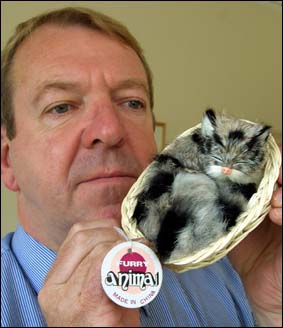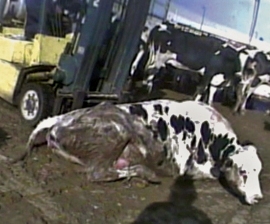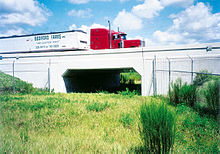For “Mammal Monday”:
_______
More than 900 arrested in China over meat contamination, including fox, rat, and mink passed off as mutton.
 “Chinese police have arrested 904 people and seized 20,000 tons of illegal products since the turn of the year, in an investigation into "meat-related offences" which revealed fox, mink and rat meat all being passed off as mutton.
“Chinese police have arrested 904 people and seized 20,000 tons of illegal products since the turn of the year, in an investigation into "meat-related offences" which revealed fox, mink and rat meat all being passed off as mutton.
Suspects in Baotou produced fake beef and lamb jerky from duck meat and sold it to markets in 15 provinces. Levels of E coli in the product "seriously exceeded standards", the country's Public Security Ministry said.” More at: http://www.independent.co.uk/news/world/asia/more-than-900-arrested-in-china-over-meat-contamination-including-fox-rat-and-mink-passed-off-as-mutton-8602842.html
-------
From Me: The term 'mutton' is rare in the United States.
Mutton — a female (ewe) or castrated male (wether) sheep having more than two permanent incisors.
Lamb — a young sheep under 12 months of age which does not have any permanent incisor teeth.
Younger lambs are smaller and more tender. Mutton is meat from a sheep over two years old, and has less tender flesh. In general, the darker the colour, the older the animal. Baby lamb meat will be pale pink, while regular lamb is pinkish-red.
Maybe you have heard the saying “Mutton Dressed up as Lamb.”
Meaning: An ageing woman who is dressed or made up as if much younger.
_______
It could be some of your best friends.

was a joint effort by The Humane Society of the Unite States/Humane Society International (HSUS/HSI) and Manfred
Karremann, a German independent journalist. 
Dog skin fur overcoats
Investigators estimate the annual death toll to be more than 2 million dogs and cats. And for what? For full-length and short coats and jackets. Fur-trimmed garments. Hats. Gloves. Decorative accessories.
 Even toy stuffed animals. This “kitten” is made from the fur of REAL dogs — farmed in horrendous circumstances in China and slaughtered for their pelts.
Even toy stuffed animals. This “kitten” is made from the fur of REAL dogs — farmed in horrendous circumstances in China and slaughtered for their pelts.
All made with the fur of dogs and cats. Dogs and cats no different from our pets, cruelly killed to make products sold to unwary consumers who generally have no way to know what they’re buying.

(As each dog was taken out and killed, the others could hear its screams and cries.)

As horrifying as this scene was, it got worse. An investigator reported that he saw dogs being butchered who were still conscious as the skinning began, and investigators videotaped a German shepherd blinking his eye as he was being skinned.” More at: http://www.animalliberationfront.com/Practical/Fishing--Hunting/Fur--Trapping/DogCatFurBooklet.pdf
and: http://www.gopetition.com/petitions/stop-chinas-fur-trade-using-dogs-and-cats.html
_______
OpEd: Cruelty to farm animals demands exposure
 “SO GUT-WRENCHING are the images — cows being shocked, turkeys being stomped, horses being burned with chemicals, piglets kicked like soccer balls — that the videos recorded by animal rights organizations at factory farms are almost impossible to watch. That, though, has helped make them effective tools in the fight against illegal and cruel treatment of farm animals.” Washington Post, April 26, 2013
“SO GUT-WRENCHING are the images — cows being shocked, turkeys being stomped, horses being burned with chemicals, piglets kicked like soccer balls — that the videos recorded by animal rights organizations at factory farms are almost impossible to watch. That, though, has helped make them effective tools in the fight against illegal and cruel treatment of farm animals.” Washington Post, April 26, 2013
More at: http://www.habitatforhorses.org/oped-cruelty-to-farm-animals-demands-exposure/
-------
First “Ag-Gag” Prosecution: Utah Woman Filmed a Slaughterhouse from the Public Street
“UPDATE: Just 24 hours after I broke this story, and following a massive amount of media coverage, prosecutors dropped all charges!”
 “Amy Meyer wanted to see the slaughterhouse for herself. She had heard that anyone passing by could view the animals, so she drove to Dale Smith Meatpacking Company in Draper City, Utah, and from the side of the road she could see through the barbed-wire fence. Piles of horns littered the property. Cows struggled with workers who tried to lead them into a building. And one scene in particular made her stop.
“Amy Meyer wanted to see the slaughterhouse for herself. She had heard that anyone passing by could view the animals, so she drove to Dale Smith Meatpacking Company in Draper City, Utah, and from the side of the road she could see through the barbed-wire fence. Piles of horns littered the property. Cows struggled with workers who tried to lead them into a building. And one scene in particular made her stop.
“A live cow who appeared to be sick or injured being carried away from the building in a tractor,” Meyer told me, “as though she were nothing more than rubble.”" More at: http://www.greenisthenewred.com/blog/first-ag-gag-arrest-utah-amy-meyer/6948/
______
Ted Danson “My Petition to the President - A Deaf Whale Is a Dead Whale”


This is why I am respectfully petitioning the President to stop seismic airgun testing in the Atlantic. Please join me and others in signing this whitehouse.gov petition as we stand up for Atlantic marine life and the people who depend on a healthy ocean. We need 100,000 ocean-inspired voices to sign and stop seismic testing.” More at: http://www.huffingtonpost.com/ted-danson/my-petition-to-the-presid_b_3185090.html
______
Private Lives of Sperm Whales
 For the first time, biologists are discovering the hidden world of sperm whales in the Caribbean
For the first time, biologists are discovering the hidden world of sperm whales in the Caribbean
“Sperm whales range throughout the world’s oceans, seas and gulfs. They may dive in excess of 6,600 feet—more than a mile—to hunt squid, their primary food, and can stay under for more than an hour. Male sperm whales grow to about 60 feet long, females to about 40. Much of the blunt head, which can account for a third of body length, is filled with a waxy, oily substance called spermaceti, once used for machine lubrication and for fueling lamps. The species was hunted for centuries for this oil and was especially beleaguered from the end of World War II until 1986, when an International Whaling Commission treaty virtually stopped commercial sperm whale hunting.” More at: http://www.nwf.org/News-and-Magazines/National-Wildlife/Animals/Archives/2012/Sperm-Whales.aspx
_______
Habitat fragmentation
“Habitat fragmentation occurs when human-made barriers such as roads, railroads, canals, electric power lines, and pipelines penetrate and divide wildlife habitat. Of these, roads have the most widespread and detrimental impacts. (Scientists estimate that the system of roads in the United States impacts the ecology of at least one-fifth of the land area of the country. For many years ecologists and conservationists have documented the adverse relationship between roads and wildlife.
The first wildlife crossings were constructed in France during the 1950s. European countries including the Netherlands, Switzerland, Germany, and France have been using various crossing structures to reduce the conflict between wildlife and roads for several decades and use a variety of overpasses and underpasses to protect and reestablish wildlife such as: amphibians, badgers, ungulates, invertebrates, and other small mammals.”
Florida State Route 46 was elevated over this underpass. Notice the channeling fences on either side of the crossing.
"Animals' Bridge," on the Flathead Indian Reservation in Montana, used by grizzly and black bears, deer, elk, mountain lions, and others
Wildlife overpass in Banff National Park, Canada
One of the two wildlife crossings spanning the A50 highway on the Veluwe in the Netherlands.

Desert tortoise using bridge underpass, Utah. Photo credit: A. McLuckie.

Wildlife overpass (7 m wide) Beaver, Utah. Note mule deer path in foreground. Photo credit: S. Rosa.
More at: http://en.wikipedia.org/wiki/Wildlife_crossing
---------
Other wildlife bridges
Rope bridges help Red squirrels across major roads


Utah built a wildlife "Overpass" in 1976 which has been much copied, and improved worldwide, and especially in North America.
Wildlife "Underpasses" are becoming more and more common. From small pipes to allow toads to migrate, to huge box culverts designed to allow bears and even moose to pass through.” More at: http://www.wildlifeextra.com/go/news/squirrel-bridges876.html#cr and: http://www.wildlifeandroads.org/decisionguide/2_1_6.cfm
_______
On This Day:
The Hindenburg disaster, May 6, 1937:
“The airship Hindenburg, the largest dirigible ever built and the pride of Nazi Germany, bursts into flames upon touching its mooring mast in Lakehurst, New Jersey, killing 36 passengers and crewmembers.
On May 3, 1937, the Hindenburg left Frankfurt, Germany, for a journey across the Atlantic to Lakehurst's Navy Air Base. Stretching 804 feet from stern to bow, it carried 36 passengers and crew of 61. Rapidly falling 200 feet to the ground, the hull of the airship incinerated within seconds. Thirteen passengers, 21 crewmen, and 1 civilian member of the ground crew lost their lives, and most of the survivors suffered substantial injuries.
Radio announcer Herb Morrison, who came to Lakehurst to record a routine voice-over for an NBC newsreel, immortalized the Hindenberg disaster in a famous on-the-scene description in which he emotionally declared, "Oh, oh, oh. It's burst into flames. Get out of the way, please . . . this is terrible . . . it's burning, bursting into flames, and is falling . . . Oh! This is one of the worst . . . it's a terrific sight . . .oh, the humanity."
The recording of Morrison's commentary was immediately flown to New York, where it was aired as part of America's first coast-to-coast radio news broadcast. Lighter-than-air passenger travel rapidly fell out of favor after the Hindenberg disaster, and no rigid airships survived World War II.”
_______
Harry Gant is oldest NASCAR winner – again, May 6, 1991:
“On this day in 1991, 51-year-old race car driver Harry Gant racks up his 12th National Association of Stock Car Auto Racing (NASCAR) Winston Cup career victory in the Winston 500 in Talladega, Alabama. In doing so, Gant bettered his own record as the oldest man ever to win a NASCAR event.”
_______
Yesterday:
When I went to pick up Jay and Muffie, Misty didn’t want to go with me for her walk. She had eaten her breakfast and just wanted to go back to bed. At her age, I’m not going to insist that she does anything, but that was a first.
Ray was cleaning the cargo-camping trailer, yes, it is still here. Jay was mowing the weeds grass, when the mulching mower stopped and started leaking oil. We dug out another old larger mower with a dull blade, and tried to swap out the blades, but we couldn’t get it off the leaky one. Jay and Ray had tools all over the place, even some out of my late Johnnie’s old toolbox. Any time my sockets and wrenches are scattered, I am right there with them. I have managed to keep those sets intact for over 50 years, even though raising a scatterbrained, hyperactive son! Nothing is worse than needing a tool and it’s missing.
Ray brought his grinder over and sharpened the blade off the larger mower. The deck had to be lowered as it had last been used to plow though some pretty tough, tall weeds. Then it wouldn't start, as it hasn’t been started for a couple of years. Jay took the spark plug out of the leaky mower, put it in the large mower and it fired right up. When Jay had finished mowing, our big concern was whether it would fit in the lawnmower shed. My mulching mower doesn’t have a discharge chute, as it just chops up all the grass and distributes it out the back, and the shed was built for it. But Ray maneuvered it in there by holding up the discharge chute flap.
Finally, I was able to put up the tools and concentrate on Muffie. I cut her down ready for her bath (shower, actually), but after that, she wanted to nap. I can’t rush Muffie, she gets upset and tries to bite my hands. She has something wrong with her joints, so I have to be very careful with her. It wasn’t too long before I was able to bathe her, finish grooming her, and take her back to her ‘Dad’.
As my hands are still swollen and sore from Gumdrop accidentally scratching me, I was glad that I was able to come through grooming Muffie unscathed yesterday.





















No comments:
Post a Comment